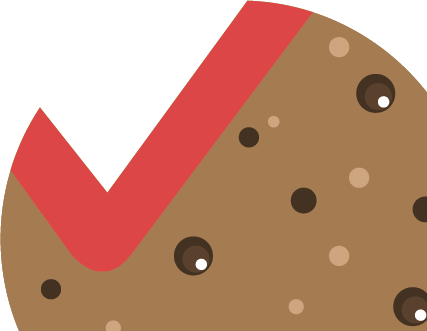Methane plume maps

About the maps
TropomiWe use the Dutch space instrument TROPOMI onboard Sentinel-5P to automatically detect large methane emission plumes across the globe. The machine-learning technology for this is described in Schuit et al. (2023). The world maps show approximate source locations based on single TROPOMI plumes and initial source rate estimates calculated using an automated mass balance method. The number of detections fluctuates from week to week because of varying emissions, cloud cover, and viewing geometry. Plumes have only been subject to initial verification. Precise quantification and final interpretation require more extensive evaluation. The detections exclude larger-scale enhancements such as seen over the Permian Basin or over wetland areas. We only show the clearest and most confident plumes here. At the end of the year, we will publish a more complete/thorough analysis of all detected plumes.
The weekly data can also be found on our FTP server.
If you use these detections for your research or other purposes, please let us know. We are happy to collaborate with anybody interested in these detections. This work is licensed under a Creative Commons Attribution 4.0 International License. When referencing the data, please credit the product generation to the SRON team (earth.sron.nl/methane-emissions/) and cite the Schuit et al. (2023) publication;Copernicus (modified) Sentinel-5p data have been used.
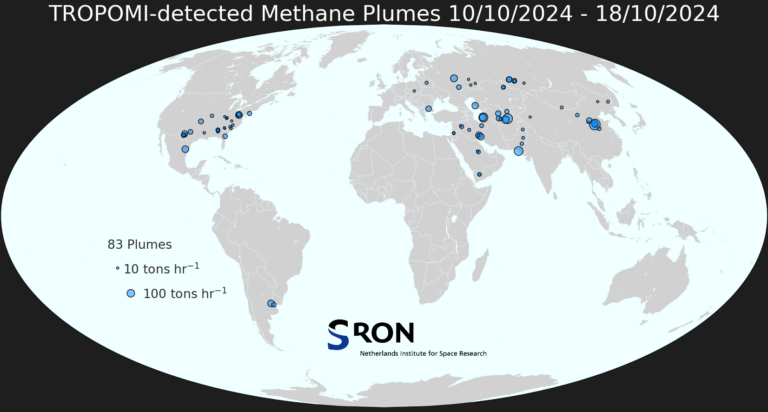
Week 42, 2024 (2024/10/21)
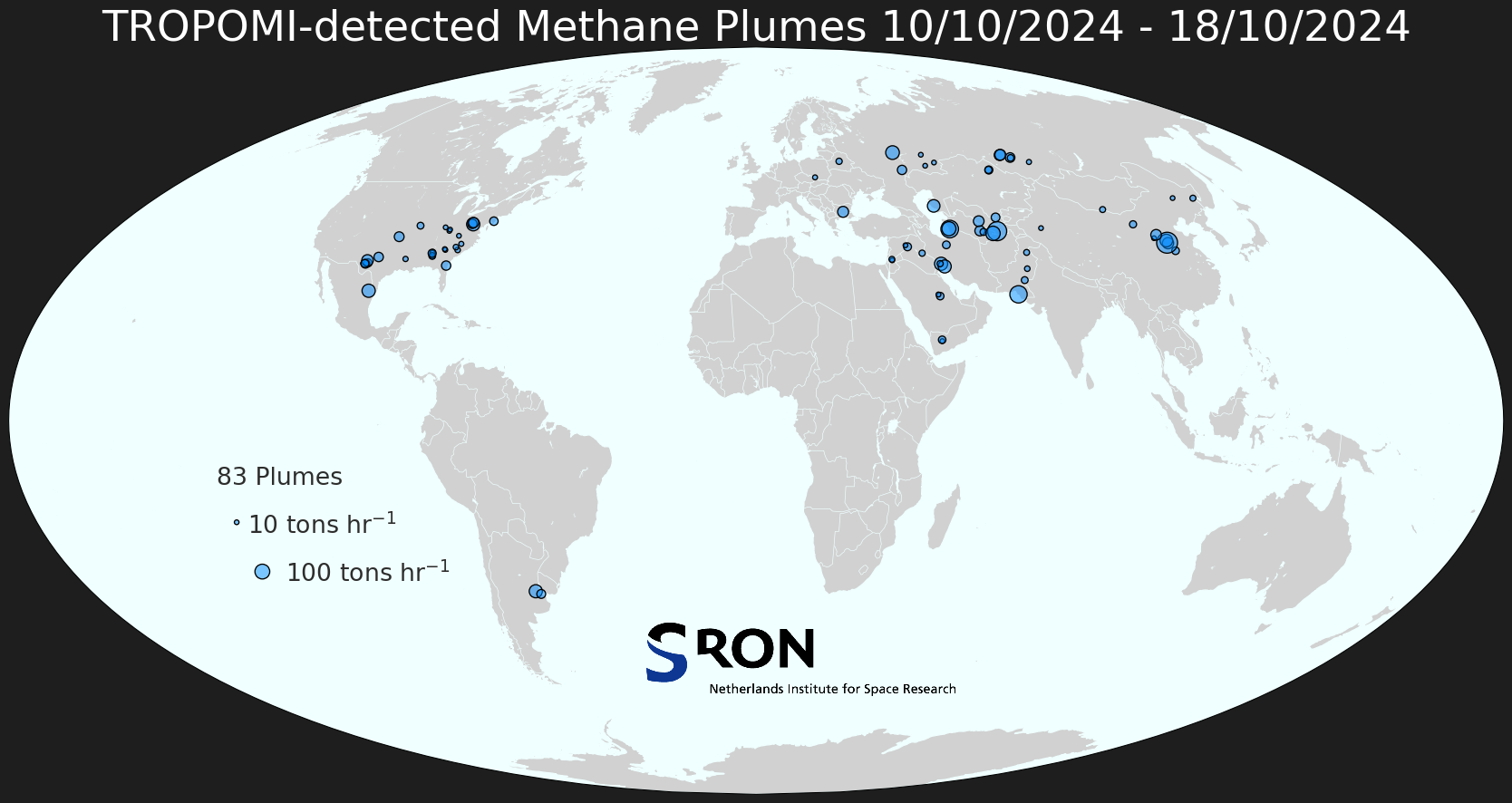
Week 42, 2024 (2024/10/21)
The Dutch space instrument TROPOMI onboard Sentinel-5P automatically detects large methane emission plumes across the globe. The machine-learning technology for this is described in Schuit et al. (2023). The world maps show approximate source locations based on single TROPOMI plumes and initial source rate estimates calculated using an automated mass balance method. The number of detections fluctuates from week to week because of varying emissions, cloud cover, and viewing geometry. Plumes have only been subject to initial verification. Precise quantification and final interpretation require more extensive evaluation. The detections exclude larger-scale enhancements such as seen over the Permian Basin or over wetland areas.
If you use these detections for your research or other purposes, please let us know. We are happy to collaborate with anybody interested in these detections. This work is licensed under a Creative Commons Attribution 4.0 International License. When referencing the data, please credit the product generation to the SRON team (earth.sron.nl/methane-emissions/) and cite the Schuit et al. (2023) publication; Copernicus (modified) Sentinel-5p data have been used.

Week 41, 2024 (2024/10/14)
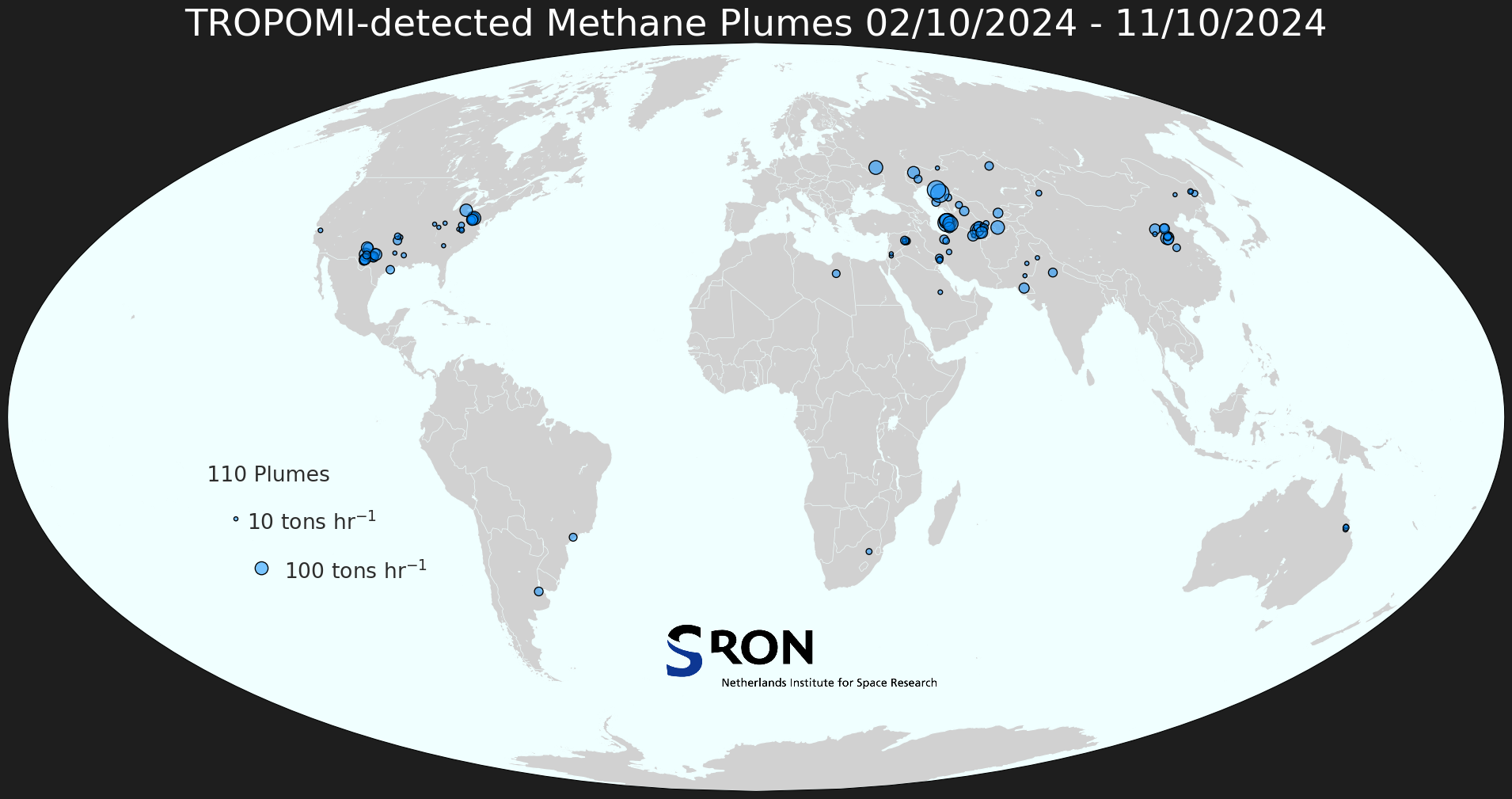
Week 41, 2024 (2024/10/14)
The Dutch space instrument TROPOMI onboard Sentinel-5P automatically detects large methane emission plumes across the globe. The machine-learning technology for this is described in Schuit et al. (2023). The world maps show approximate source locations based on single TROPOMI plumes and initial source rate estimates calculated using an automated mass balance method. The number of detections fluctuates from week to week because of varying emissions, cloud cover, and viewing geometry. Plumes have only been subject to initial verification. Precise quantification and final interpretation require more extensive evaluation. The detections exclude larger-scale enhancements such as seen over the Permian Basin or over wetland areas.
If you use these detections for your research or other purposes, please let us know. We are happy to collaborate with anybody interested in these detections. This work is licensed under a Creative Commons Attribution 4.0 International License. When referencing the data, please credit the product generation to the SRON team (earth.sron.nl/methane-emissions/) and cite the Schuit et al. (2023) publication; Copernicus (modified) Sentinel-5p data have been used.
Week 40, 2024 (2024/10/07)
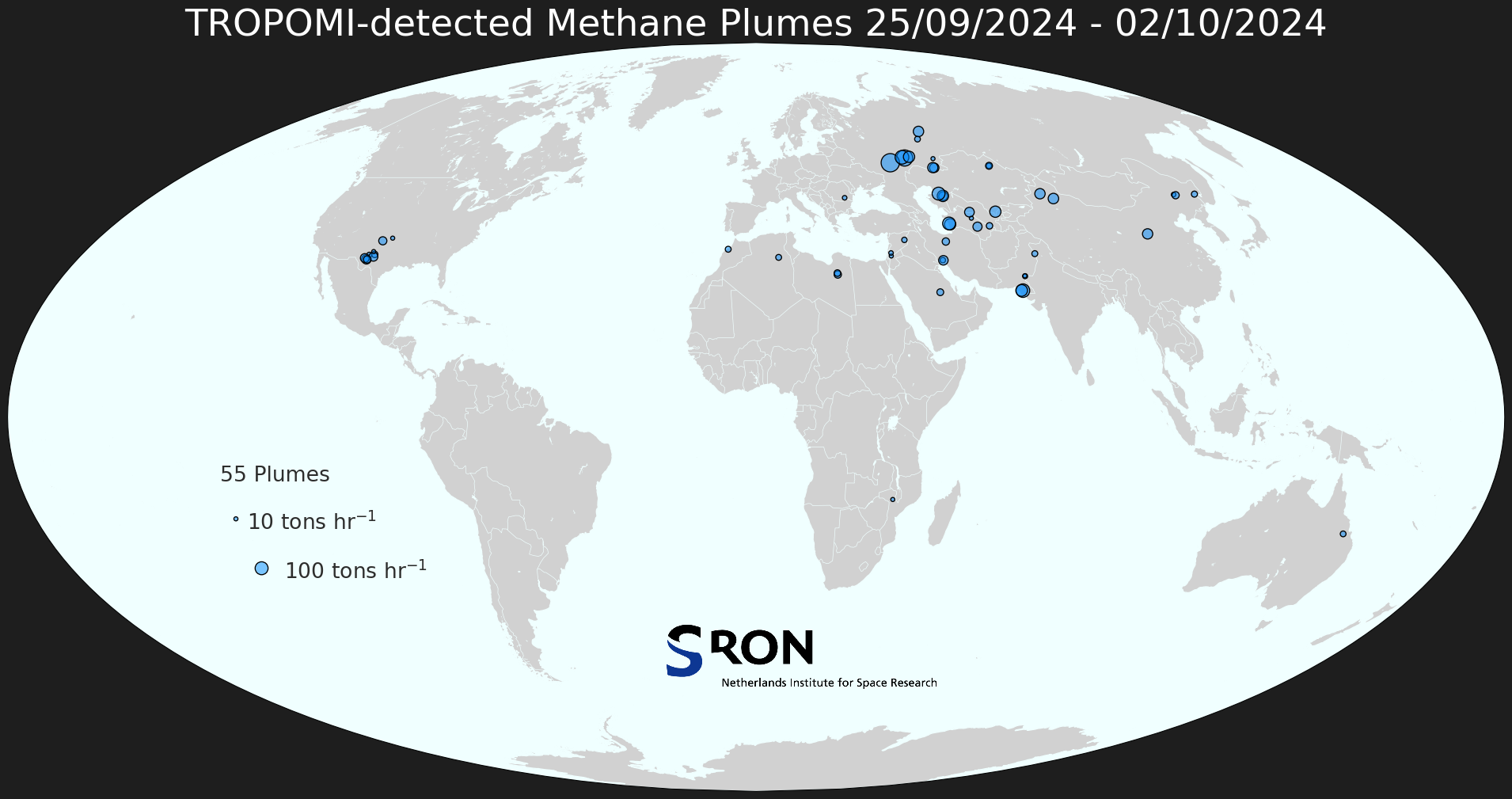
Week 40, 2024 (2024/10/07)
The Dutch space instrument TROPOMI onboard Sentinel-5P automatically detects large methane emission plumes across the globe. The machine-learning technology for this is described in Schuit et al. (2023). The world maps show approximate source locations based on single TROPOMI plumes and initial source rate estimates calculated using an automated mass balance method. The number of detections fluctuates from week to week because of varying emissions, cloud cover, and viewing geometry. Plumes have only been subject to initial verification. Precise quantification and final interpretation require more extensive evaluation. The detections exclude larger-scale enhancements such as seen over the Permian Basin or over wetland areas.
If you use these detections for your research or other purposes, please let us know. We are happy to collaborate with anybody interested in these detections. This work is licensed under a Creative Commons Attribution 4.0 International License. When referencing the data, please credit the product generation to the SRON team (earth.sron.nl/methane-emissions/) and cite the Schuit et al. (2023) publication; Copernicus (modified) Sentinel-5p data have been used.
Week 39, 2024 (2024/09/30)
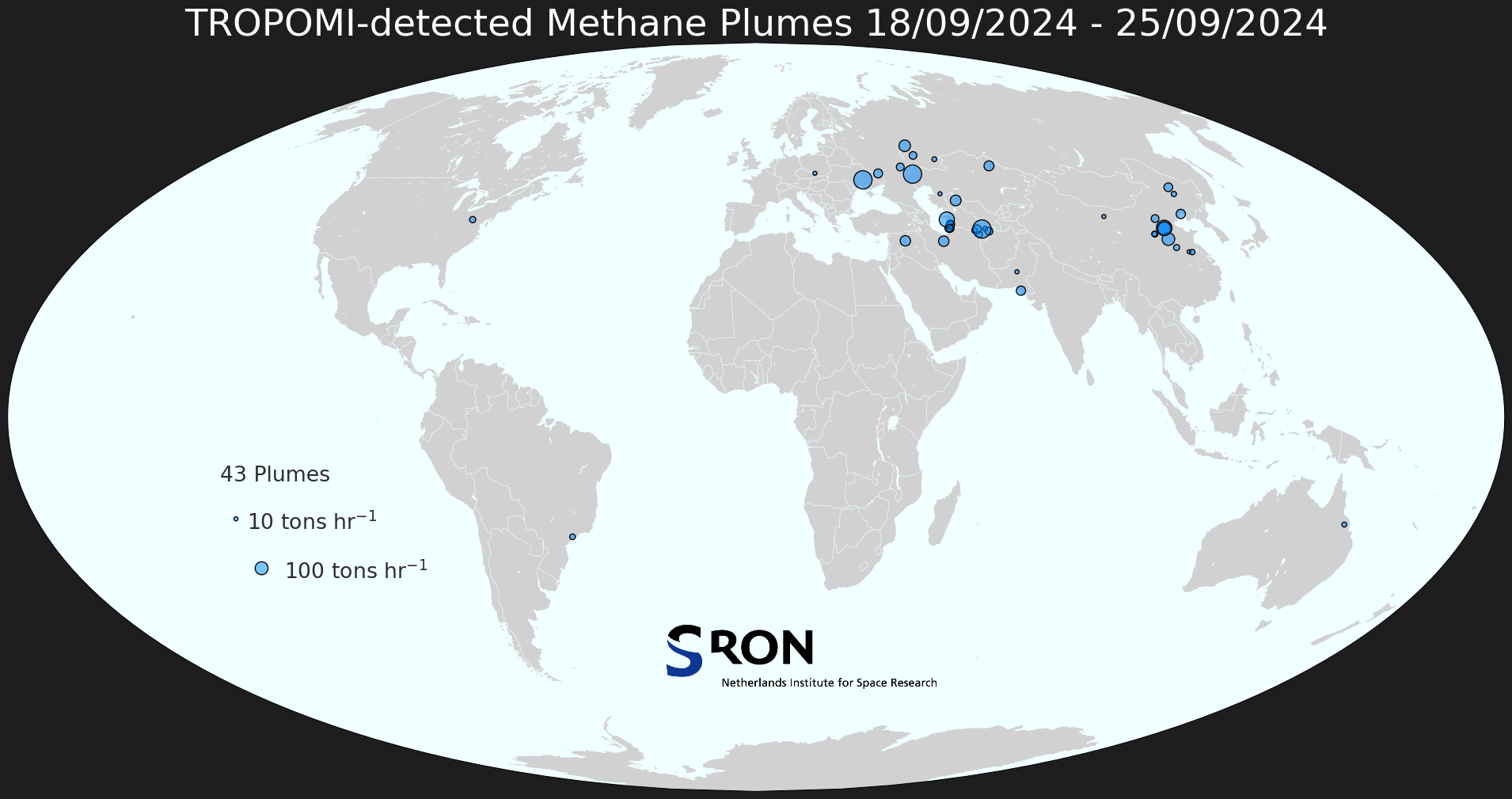
Week 39, 2024 (2024/09/30)
The Dutch space instrument TROPOMI onboard Sentinel-5P automatically detects large methane emission plumes across the globe. The machine-learning technology for this is described in Schuit et al. (2023). The world maps show approximate source locations based on single TROPOMI plumes and initial source rate estimates calculated using an automated mass balance method. The number of detections fluctuates from week to week because of varying emissions, cloud cover, and viewing geometry. Plumes have only been subject to initial verification. Precise quantification and final interpretation require more extensive evaluation. The detections exclude larger-scale enhancements such as seen over the Permian Basin or over wetland areas.
If you use these detections for your research or other purposes, please let us know. We are happy to collaborate with anybody interested in these detections. This work is licensed under a Creative Commons Attribution 4.0 International License. When referencing the data, please credit the product generation to the SRON team (earth.sron.nl/methane-emissions/) and cite the Schuit et al. (2023) publication; Copernicus (modified) Sentinel-5p data have been used.
Week 38, 2024 (2024/09/23)
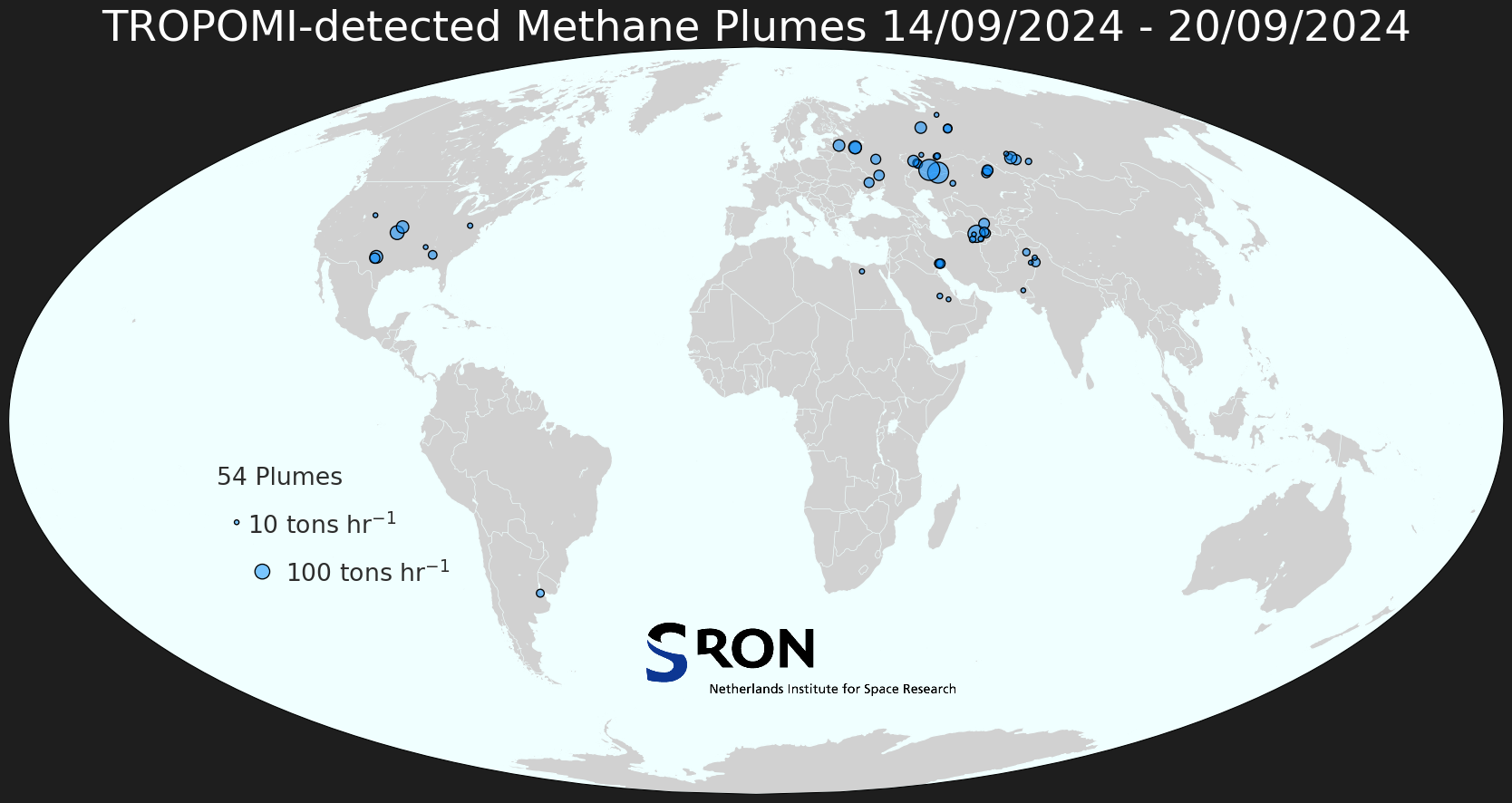
Week 38, 2024 (2024/09/23)
The Dutch space instrument TROPOMI onboard Sentinel-5P automatically detects large methane emission plumes across the globe. The machine-learning technology for this is described in Schuit et al. (2023). The world maps show approximate source locations based on single TROPOMI plumes and initial source rate estimates calculated using an automated mass balance method. The number of detections fluctuates from week to week because of varying emissions, cloud cover, and viewing geometry. Plumes have only been subject to initial verification. Precise quantification and final interpretation require more extensive evaluation. The detections exclude larger-scale enhancements such as seen over the Permian Basin or over wetland areas.
If you use these detections for your research or other purposes, please let us know. We are happy to collaborate with anybody interested in these detections. This work is licensed under a Creative Commons Attribution 4.0 International License. When referencing the data, please credit the product generation to the SRON team (earth.sron.nl/methane-emissions/) and cite the Schuit et al. (2023) publication; Copernicus (modified) Sentinel-5p data have been used.
Week 37, 2024 (2024/09/16)

Week 37, 2024 (2024/09/16)
The Dutch space instrument TROPOMI onboard Sentinel-5P automatically detects large methane emission plumes across the globe. The machine-learning technology for this is described in Schuit et al. (2023). The world maps show approximate source locations based on single TROPOMI plumes and initial source rate estimates calculated using an automated mass balance method. The number of detections fluctuates from week to week because of varying emissions, cloud cover, and viewing geometry. Plumes have only been subject to initial verification. Precise quantification and final interpretation require more extensive evaluation. The detections exclude larger-scale enhancements such as seen over the Permian Basin or over wetland areas.
If you use these detections for your research or other purposes, please let us know. We are happy to collaborate with anybody interested in these detections. This work is licensed under a Creative Commons Attribution 4.0 International License. When referencing the data, please credit the product generation to the SRON team (earth.sron.nl/methane-emissions/) and cite the Schuit et al. (2023) publication; Copernicus (modified) Sentinel-5p data have been used.
Week 36, 2024 (2024/09/09)
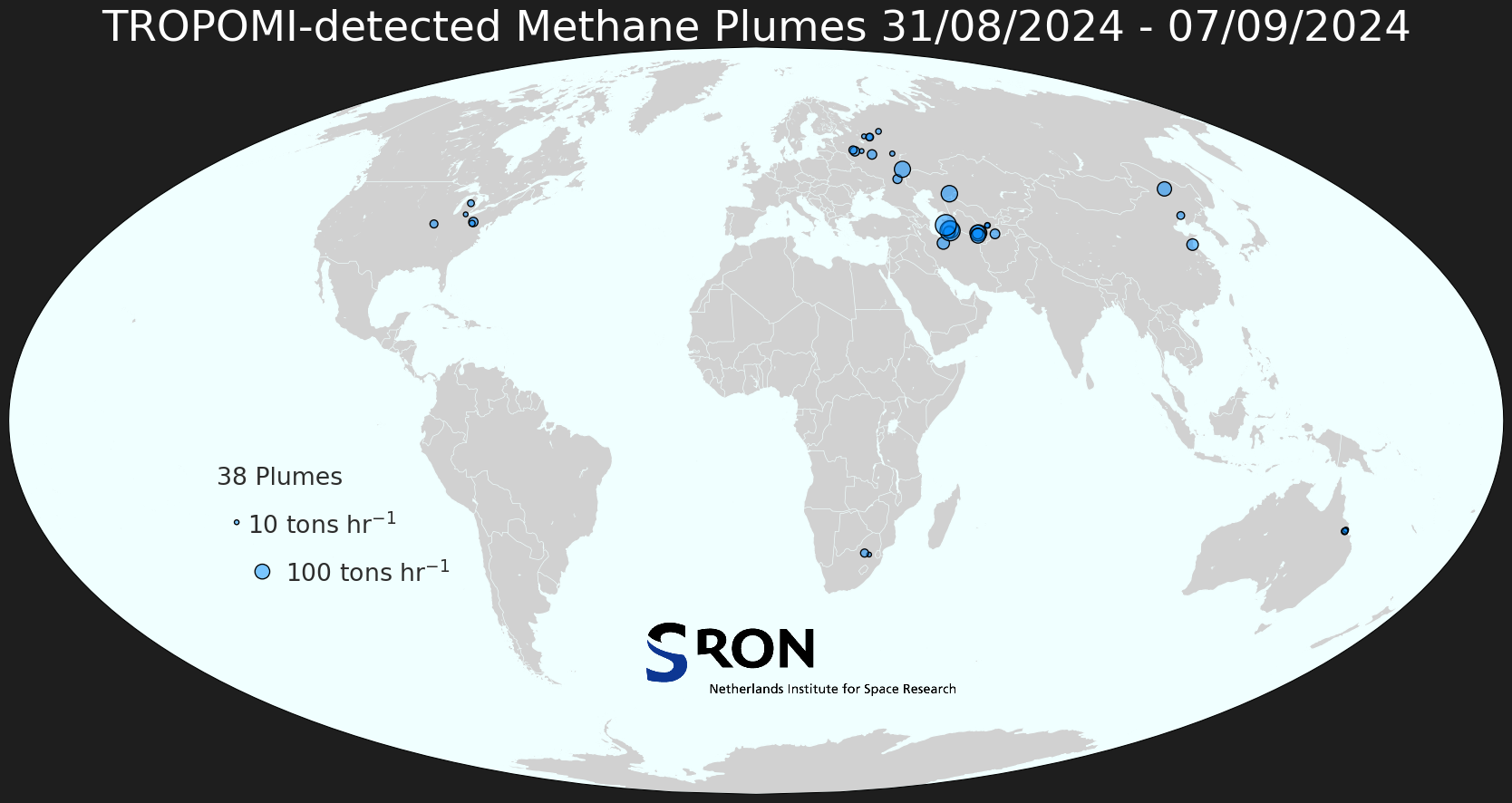
Week 36, 2024 (2024/09/09)
The Dutch space instrument TROPOMI onboard Sentinel-5P automatically detects large methane emission plumes across the globe. The machine-learning technology for this is described in Schuit et al. (2023). The world maps show approximate source locations based on single TROPOMI plumes and initial source rate estimates calculated using an automated mass balance method. The number of detections fluctuates from week to week because of varying emissions, cloud cover, and viewing geometry. Plumes have only been subject to initial verification. Precise quantification and final interpretation require more extensive evaluation. The detections exclude larger-scale enhancements such as seen over the Permian Basin or over wetland areas.
If you use these detections for your research or other purposes, please let us know. We are happy to collaborate with anybody interested in these detections. This work is licensed under a Creative Commons Attribution 4.0 International License. When referencing the data, please credit the product generation to the SRON team (earth.sron.nl/methane-emissions/) and cite the Schuit et al. (2023) publication; Copernicus (modified) Sentinel-5p data have been used.
Week 35, 2024 (2024/09/02)
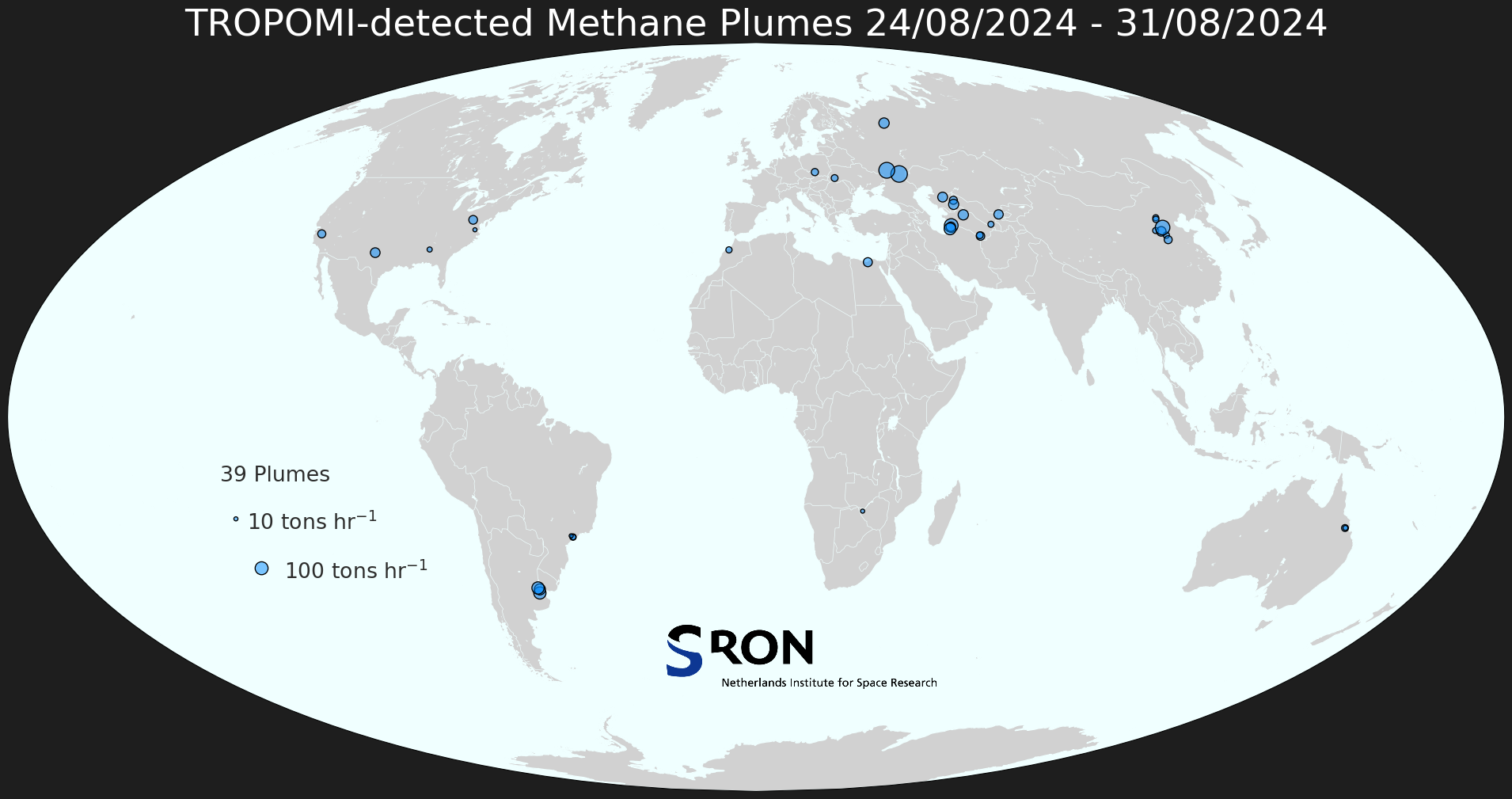
Week 35, 2024 (2024/09/02)
The Dutch space instrument TROPOMI onboard Sentinel-5P automatically detects large methane emission plumes across the globe. The machine-learning technology for this is described in Schuit et al. (2023). The world maps show approximate source locations based on single TROPOMI plumes and initial source rate estimates calculated using an automated mass balance method. The number of detections fluctuates from week to week because of varying emissions, cloud cover, and viewing geometry. Plumes have only been subject to initial verification. Precise quantification and final interpretation require more extensive evaluation. The detections exclude larger-scale enhancements such as seen over the Permian Basin or over wetland areas.
If you use these detections for your research or other purposes, please let us know. We are happy to collaborate with anybody interested in these detections. This work is licensed under a Creative Commons Attribution 4.0 International License. When referencing the data, please credit the product generation to the SRON team (earth.sron.nl/methane-emissions/) and cite the Schuit et al. (2023) publication; Copernicus (modified) Sentinel-5p data have been used.


